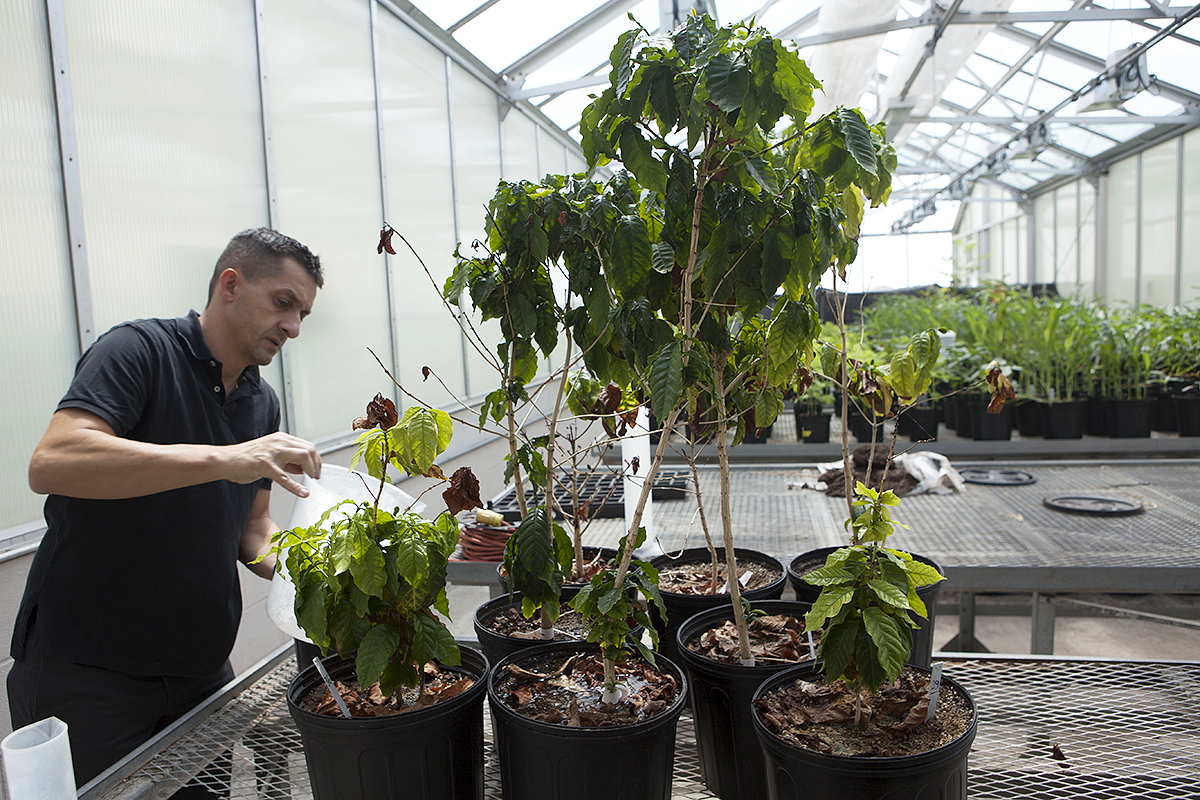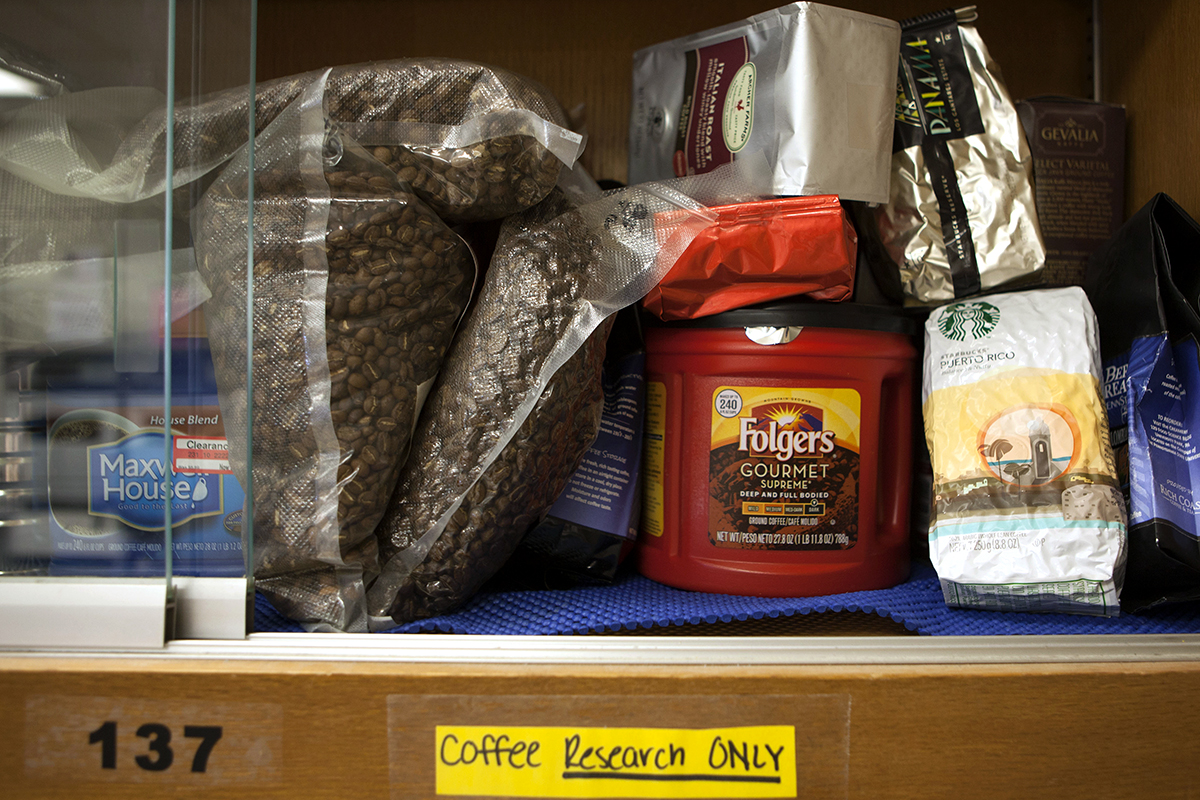Texas A&M Researchers Working to Avert a Global Coffee Crisis
By Anna Casey
Reporting Texas

Professor Leo Lombardini waters a coffee plant from Yemen in a greenhouse at Texas A&M University in College Station, Texas. Another professor was able to bring the plants back before conflict broke out there.
COLLEGE STATION — Leo Lombardini poured water on a cluster of coffee plants native to Yemen, making sure to soak the soil on a hot September afternoon. Lombardini wasn’t on the Arabian Peninsula, where these plants originated. He was in a rooftop greenhouse at Texas A&M University, where he directs the new Center for Coffee Research and Education.
The rows of coffee plants in the greenhouse, on top of a laboratory building west of the university’s football stadium, could help save coffee crops in regions such as South and Central America, where climate change threatens one of the oldest and most widely consumed beverages on Earth.
The center also is focused on increasing crop yields to meet rising worldwide demand. In the United States, the National Coffee Association says, the industry generates $225 billion a year.
Researchers at Texas A&M are trying to create a coffee plant that is more resistant to disease and the effects of global warming without compromising the taste of the beans. Other U.S. research institutions study the health effects of coffee (for example, Vanderbilt University) or roasting technology (for instance, at University of California Davis). But the study of coffee plant genetics in College Station is unique.
“There’s plenty of corn and soybean research, but there was a void in coffee research. It’s an orphan crop,” said Lombardini, who was born in Italy.
The center has a $200,000 annual budget, two full-time employees and more than a dozen collaborators. It is housed at Texas A&M University’s Borlaug Institute for International Agriculture, which since 2006 has encouraged farmers in underdeveloped countries, notably Rwanda, to adopt coffee as a cash crop.
According to Steve Topik, a history professor at University of California Irvine and expert on coffee production, coffee is easy to grow in the appropriate soil and climate and requires little infrastructure.
But coffee grows best in cool climates, and the forecast is grim for the world’s 25 million farmers whose livelihoods depend on it and the 133 million Americans who can’t start their day without it.
According to World Coffee Research, a nonprofit that collaborates with the Center for Coffee Research and Education, the area suitable for growing arabica coffee, the most popular variety, will shrink by 50 percent by 2050 due to rising global temperatures. In Brazil — a country synonymous with coffee and the world’s largest arabica producer — the amount of land available to grow arabica is expected to decline by 95 percent by 2100.

Tasting experts at the university will assess coffee quality in the sensory lab. Photo by Anna Casey for Reporting Texas
Some Texas coffee roasters say they already are noticing the effects of climate change on their businesses and their suppliers.
“It seems like a shift in the season, almost,” said Mike McKim, founder and CEO of Cuvée Coffee in Spicewood, 35 miles northwest of Austin. McKim visits the farms in Latin American and Africa where he sources his coffee about three months out of the year.
“I’ve seen firsthand some massive changes in the times that they harvest” because of climate change, he said. “They’re scrambling to get workers” because the crop may be ready sooner or later than usual.
Disease, such as a fungus called rust that kills leaves and affects the yield and quality of beans, is another concern, McKim said.
“One of the farmers we work with lost 70 percent of their crop to coffee rust,” he said. The surviving plants produced lower-quality beans. The quality used to be great, and then it was good,” he said. McKim said he continued to buy from the man because he didn’t want to destroy his livelihood.
Lombardini and his small team of researchers are confronting the threat posed by climate change. But like the search for any scientific breakthrough, it’s not easy.
“Breeding for coffee is a long process. If you get a good variety, that’s a success,” Lombardini said. “We’re just at the beginning. We’re just trying to understand genetics, screening crosses… probably a few years away from breeding coffee.”
Of the two main species of coffee plants, arabica is preferred over robusta for its taste and is the most widely produced and consumed. But it’s also more sensitive to temperature and climate fluctuations.
Arabica, with its fragrant flowers, grows best in regions where the mean temperature does not exceed 68 degrees Fahrenheit. In some areas, such as the mountains of Mexico, where temperatures are rising, arabica farmers are being forced to grow at higher altitudes where it’s cooler but where surface area for farming is limited.
Robusta coffee tolerates temperature changes better and can be grown at lower altitudes. But its bitter taste and high caffeine content mean it’s used primarily as filler for cheaper products, instant coffee or energy drinks.
What Texas A&M researchers hope to create is a variety of coffee that has the taste of arabica with the robustness and resilience of robusta. They’re working to identify genes that play roles in each trait. The problem, Lombardini said, is that the arabica variety consumers demand isn’t very genetically diverse — about 98 percent of the genetic matter is identical, so disease can spread quickly.
“Arabica is self-fertile, so there’s a lot of inbreeding, which doesn’t help genetic diversity,” Lombardini said.
The university’s coffee research brought Bárbara Barbosa, a post-doctoral fellow, from her home country, Brazil, to College Station.
Barbosa is studying the genome of second-generation, cross-bred plants from Nicaragua to identify which characteristics of the parents have been transmitted to the second generation.
“The aim of this whole project is to obtain a plant less susceptible to rust and find in the genotype what’s giving that characteristic to those plants,” Barbosa said.
It could take years before her efforts pay off, but for Barbosa, coffee research is motivated by more than just the study of a plant.
“It’s such an important crop, not only in economic terms, but socially,” she said. “A lot of families depend on coffee. To be able to improve the lives of these families is very exciting for me.”
This story has been corrected to say that Brazil is the world’s largest producer of arabica coffee, not the third largest.